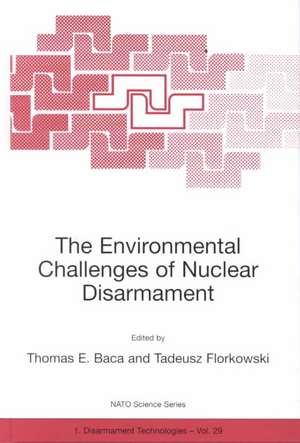The Environmental Challenges of Nuclear Disarmament: NATO Science Partnership Subseries: 1, cartea 29
Editat de Thomas E. Baca, Tadeusz Florkowskien Limba Engleză Hardback – 31 aug 2000
| Toate formatele și edițiile | Preț | Express |
|---|---|---|
| Paperback (1) | 643.84 lei 6-8 săpt. | |
| SPRINGER NETHERLANDS – 31 aug 2000 | 643.84 lei 6-8 săpt. | |
| Hardback (1) | 650.37 lei 6-8 săpt. | |
| SPRINGER NETHERLANDS – 31 aug 2000 | 650.37 lei 6-8 săpt. |
Din seria NATO Science Partnership Subseries: 1
- 15%
 Preț: 643.65 lei
Preț: 643.65 lei - 18%
 Preț: 949.23 lei
Preț: 949.23 lei - 18%
 Preț: 951.14 lei
Preț: 951.14 lei - 18%
 Preț: 950.96 lei
Preț: 950.96 lei - 18%
 Preț: 1226.42 lei
Preț: 1226.42 lei -
 Preț: 392.97 lei
Preț: 392.97 lei - 18%
 Preț: 944.36 lei
Preț: 944.36 lei - 18%
 Preț: 1227.04 lei
Preț: 1227.04 lei - 18%
 Preț: 1220.26 lei
Preț: 1220.26 lei - 18%
 Preț: 947.35 lei
Preț: 947.35 lei - 18%
 Preț: 952.09 lei
Preț: 952.09 lei - 18%
 Preț: 955.56 lei
Preț: 955.56 lei - 15%
 Preț: 643.65 lei
Preț: 643.65 lei - 18%
 Preț: 947.67 lei
Preț: 947.67 lei - 18%
 Preț: 1111.97 lei
Preț: 1111.97 lei - 18%
 Preț: 1230.66 lei
Preț: 1230.66 lei - 5%
 Preț: 2125.27 lei
Preț: 2125.27 lei - 15%
 Preț: 650.86 lei
Preț: 650.86 lei - 18%
 Preț: 949.23 lei
Preț: 949.23 lei - 15%
 Preț: 640.37 lei
Preț: 640.37 lei - 18%
 Preț: 1225.16 lei
Preț: 1225.16 lei -
 Preț: 391.40 lei
Preț: 391.40 lei - 18%
 Preț: 945.14 lei
Preț: 945.14 lei - 5%
 Preț: 1407.87 lei
Preț: 1407.87 lei -
 Preț: 398.15 lei
Preț: 398.15 lei -
 Preț: 390.46 lei
Preț: 390.46 lei
Preț: 650.37 lei
Preț vechi: 765.14 lei
-15% Nou
Puncte Express: 976
Preț estimativ în valută:
124.46€ • 129.46$ • 102.75£
124.46€ • 129.46$ • 102.75£
Carte tipărită la comandă
Livrare economică 14-28 aprilie
Preluare comenzi: 021 569.72.76
Specificații
ISBN-13: 9780792362029
ISBN-10: 0792362020
Pagini: 354
Ilustrații: XI, 354 p.
Dimensiuni: 155 x 235 x 22 mm
Greutate: 0.69 kg
Ediția:2000
Editura: SPRINGER NETHERLANDS
Colecția Springer
Seria NATO Science Partnership Subseries: 1
Locul publicării:Dordrecht, Netherlands
ISBN-10: 0792362020
Pagini: 354
Ilustrații: XI, 354 p.
Dimensiuni: 155 x 235 x 22 mm
Greutate: 0.69 kg
Ediția:2000
Editura: SPRINGER NETHERLANDS
Colecția Springer
Seria NATO Science Partnership Subseries: 1
Locul publicării:Dordrecht, Netherlands
Public țintă
ResearchCuprins
Environmental Issues Associated With Nuclear Disarmament.- 1. Post-Arms Race Clean-Up Effort in the United States of America.- 2. Some Comparisons of Plutonium-Bearing Rad waste Management in the USA and Russia.- 3. International Training Centre for Analysing Nuclear and Radiation Safety.- 4. Radioactive Contamination and Waste Management in the Former Soviet Union; Opportunities for Stydying Anthropogenic Analogues of Radioactive-Waste Repositories.- 5. Legacy of Actinides in the Weapons Complex.- Preventing Proliferation of Nuclear Materials.- 6. Fuel Cycle of Large-Scale Nuclear Energy (BREST-1200) with Non-Proliferation of Plutonium and Equivalent Disposal of Radioactive Waste.- 7. Ceramic Waste Forms for Excess Weapons Plutonium.- 8. Long-Term Solutions to Managing Nuclear Waste in the Russian Federation.- 9. Thorium Phosphates as Matrices for Radionuclide Immobilisation.- 10. Modeling Spent Nuclear UO2-Fuel Dissolution Under Repository Conditions.- Nuclear Facility Decontamination and Decommissioning.- 11. IAEA Programme on the Identification and Remediation of Contaminated Nuclear Sites.- 12. Electro-physical Methods of Decontamination of Radioactive Equipment Surfaces.- 13. Electro-Chemical Methods for Decontaminating and Treating Radioactive Waste Resulting From Weapons-Facilities Clean-Up.- 14. Decommissioning of Nuclear Installations and Dismantling Techniques.- 15. Packaging of Plutonium Metal and Oxide in the ARIES Project.- Applying Nuclear Weapons Expertise To Civilian Use.- 16. Removal and Use of the Large-Scale Radioactive Equipment of Nuclear Submarines.- 17. Nuclear Technology for Cleaning Coal Emissions; Example of International Cooperation Leading to the Application of a Nuclear Technology to the Civilian Sector.- 18. Environmental Aspects of the Loss of Nuclear-Powered Ships.- 19. U.S.-Russian Weapons Sites Collaborations on Environmental Problems.- 20. Adsorbents for Stabilising Radionuclides from Solution.- Treatment of Nuclear Waste And Remediation of Contaminated Sites.- 21. Advanced Thermo-Chemical Technologies for the Treatment of Radioactive Organic and Biological Waste.- 22. Clean-Up of Nuclear Weapons Facilities.- 23. Risk-Assessment Model for Evaluating Environmental Remediation Options at the Stráž Underground Uranium Leaching Site.- 24. Soil-to-Plant Transfer of Radionuclides.- 25. Radiological Characterisation of Low- and Medium-Level Nuclear Wastes.- 26. PMS: A Simple Technology for Clean-Up of Heavy Metals and Radionuclides Throughout the World.- 27. Inorganic Ion Exchangers as Selective Adsorbents and Potential Primary Barriers for Radionuclides.- Nuclear Waste Management and Disposal.- 28. Use of Conservant ‘F’ for Radioactive and Chemical Solid Waste Disposal.- 29. Managing Institutional LILW in Central Russia: Operational Experience.- 30. Aspects of the Migration of Long-Lived Radionuclides from Underground Waste Repositories.- 31. Systems Approach to the Safety Evaluation of Radioactive Waste Management Options.- 32. Expertise in Low-Level Radioactive Waste Management in Belarus.- 33. Radionuclide Co-Precipitation Studies Under Repository Conditions.- Long-Term Surveillance of Monitoring of Nuclear Materials.- 34. Measurements and Modelling of Radionuclide Migration into Various Types of Soil.- 35. Sand Reactor.- 36. Advanced Portable Thermoluminescent Dosimeter System for Monitoring Environmental Radiation.- 37. Speciation in Water Released From Mining and Milling Facilities.- Attachment A Technologies and Needs for Potential Long-Term Collaborations.- Attachment B Nato AdvancedResearch Workshop Participant List.- Author and Subject Index.



















